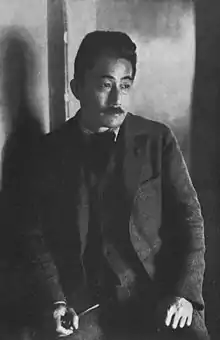Kaoru Osanai
Kaoru Osanai (小山内 薫, Osanai Kaoru, 26 July 1881 – 25 December 1928) was a Japanese theater director, playwright, and actor central in the development of modern Japanese theater.
Kaoru Osanai | |
|---|---|
 Kaoru Osanai in 1927 | |
| Born | July 26, 1881 |
| Died | December 25, 1928 (aged 47) |
| Nationality | Japanese |
| Occupation | Theatre director, playwright |
Biography
Graduating from Tokyo University, Osanai founded the Free Theater (Jiyū Gekijō) with Ichikawa Sadanji II in 1909 and staged translations of Ibsen, Chekov, and Gorky,[1] but there he experienced the limits of doing realist theater with kabuki actors.[2] Osanai described these limits as an "existing theatrical poison", for he aimed to extend the boundaries of kabuki as part of the shingeki movement.[3] Osanai was one of the many animators who contributed toward defining the fundamental aspects of shingeki theatre.[4] His first production with the Free Theater, John Gabriel Borkman, brought Western naturalist and modernist drama which would challenge social conventions. Between December 1912 and August 1913, Osanai traveled throughout Europe to experience modern theater first-hand. He was particularly impressed with the work of the Moscow Art Theatre.[5] After returning to Japan in 1920, he worked as the research director of the Shochiku Cinema[1] before he helped found the Tsukiji Little Theater in 1924 and continued to influence shingeki theater. He also played an important role in film history when he was hired by Shochiku in 1920 to head their actors school. He helped produce and appeared in Souls on the Road, a groundbreaking work in Japanese cinema, and raised such important film talents as Minoru Murata, Kiyohiko Ushihara, Daisuke Itō, Yasujirō Shimazu, and Denmei Suzuki. He also taught at Keio University and helped support such young writers as Jun'ichirō Tanizaki.[1]
The list of plays that were staged in the theatre did not include plays by Kikuchi Kan, Kunio Kishida, and Yūzō Yamamoto.[6]
References
- "Kaoru Osanai". Prominent People of Minato City. Retrieved 2 July 2010.
- Brandon, James R.; Goodman, David G (2000). "Japan". The Cambridge Guide to Theatre. Cambridge University Press. p. 566.
- Morinaga, Maki Isaka (2005). "Osanai Kaoru's Dilemma: "Amateurism by Professionals" in Modern Japanese Theatre". TDR 1988. The MIT Press. p. 119.
- Ottaviani, Giovi (1994). ""Difference" and "Reflexivity": Osanai Kaoru and the Shingeki Movement". Asian Theatre Journal. Asian Theatre Journal. 11 (2): 213–230. doi:10.2307/1124229. JSTOR 1124229.
- Matsumoto, Shinko (1995). "Osanai Kaoru's Views on Russian Theatre". In Rimer, J. Thomas (ed.). A Hidden Fire: Russian and Japanese Cultural Encounters, 1868-1926. Stanford: Stanford University Press. p. 69.
- Constantinidis, Stratos E. (2007). Text & Presentation, 2006. McFarland. p. 177.
External links
- Osanai Kaoru at Aozora Bunko (in Japanese)
- Kaoru Osanai at IMDb
- Works by or about Kaoru Osanai at Internet Archive